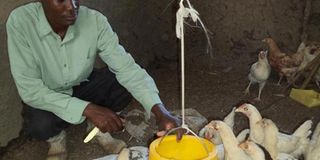Mixing chickens of various breeds cost me dearly

Erastus Ouma with some of the poultry that he keeps at his farm in Kandaria, Kisumu County. He lost some of his chickens when he mixed them with indigenous breeds without taking precautions. PHOTO | EVERLINE OKEWO |
What you need to know:
- Farmer left counting his losses after his free-range chickens infect the more susceptible exotic ones when he mixed them unknowingly.
- Ensure chicken from different sources are quarantined and treated before mixing them.
Dressed in a beige shirt, grey trousers and white gumboots, Erastus Ouma walks into one of his chicken coops in Kandaria village in Nyakach, Kisumu County.
He opens the door of the pen only to find five cockerels hurdled in a corner, an indication that they are sick. “I called a vet last week and he treated them but it is clear they are still sick. I am afraid I will lose more birds,” he says almost in desperation.
He attempts to offer them some feeds but the birds are not interested. The previous week, Ouma, who keeps 400 birds of the Kenbro breed, 200 which are cockerels and 200 chicks, had lost 20 birds to coccidiosis.
“This disease started after I mixed some five birds kept under free-range system with the others in the pen. The new birds were infected, leading to an outbreak of this disease,” says the 26-year-old farmer who invested about Sh100,000 in the business after buying chicks at Sh100 each.
When he mixed the five birds that his mother was rearing with the rest, all was well at first.
Signs of trouble appeared after about a week. “The improved breeds started to die, at least one every day, despite me administering drugs that include Biotrim vet and Fosbac. I took away the indigenous chicken but it was too late,” he says.
Ouma, who keeps the birds mainly for meat, lost about Sh20,000 since he was to sell each of the four-month-old Kenbro cocks at maturity in six months at Sh1,000 each to traders and families in Nyakach.
CAUSES BLEEDING
Coccidiosis is caused by a microscopic parasite known as coccidia.
The parasite attaches itself to the lining of the gut, multiplies and becomes an oocyst, feeding on the digestive tract of the bird and making it bleed thereafter.
One of the symptoms of coccidiosis is that the chickens produce blood-stained droppings and they cough.
Coccidia is found in contaminated ground. It can be transferred through contaminated boots, clothing, feed sacks, insects and rodents and more often, birds are exposed to the parasite through their droppings, dirty drinkers and damp litter in their housing.
Amos Amenya, an agronomist at the Lake Basin Development Authority, advises against mixing free-range birds with those kept under the intensive system, especially improved breeds.
“Improved breeds like Kenbrow have low resistance to disease. On the other hand, free-range indigenous birds have high disease-resistance. However, when you want to mix them, ensure you treat or vaccinate the new birds, and isolate them for several days as you monitor them before mixing.”
But before the birds are isolated, the farmer should ensure the poultry house is fumigated and dusted using brooding dust.
“For chicks, gumboro vaccine should be administered when they are one week old. After 14 days, the chicken should be vaccinated against Newcastle. The third vaccine is gumboro followed by small pox.”
Amenya further warns that mixing mature birds with young ones may also lead to starvation. “The big birds are likely to fight the young ones while feeding and this could result in starvation and deaths,” he says, advising farmers to mix birds of the same age only.
He notes chickens should be dewormed after every three months. “If worms attack the birds, symptoms include diarrhoea. Whitish diarrhoea could be a sign of Newcastle while blood-stained dropping could be a sign of worm infestation.”
Ouma also engages in goat rearing, livestock keeping and horticulture farming.
He plans to use money he gets from farming to enrol for a degree course in animal husbandry at Egerton University.




